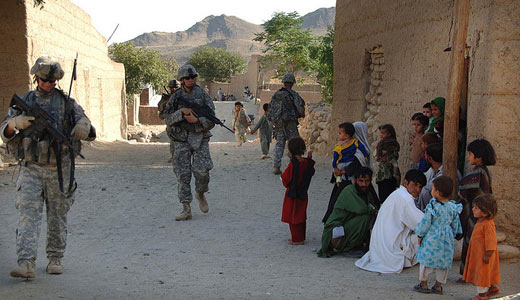
From the ice-bound passes of the Hindu Kush to the blazing heat of the Karakum Desert, Central Asia is a sub-continent steeped in illusion. For more than two millennia conquerors have been lured by the mirage that it is a gateway to immense wealth: China to the east, India to the south, Persia to the west, and to the north, the riches of the Caspian basin. Greeks, Persians, Arabs, Mongols, British, and Soviets have all come and gone, leaving behind little more than forgotten graveyards and the detritus of war.
Americans and our NATO allies are next.
It is a cliché that Afghanistan is the graveyard of empires, but a cliché doesn’t mean something is not true, just that it is repeated over and over again until the phrase becomes numbing. It is a tragedy that the US was “numb” to that particular platitude, although we have company. In the past 175 years England has invaded Afghanistan four times.
Our 2001 invasion was itself built on a myth-that the Taliban had attacked the US on 9/11 was fabricated to lay the groundwork for the invasion of Iraq 17 months later. That both invasions turned into disasters is hardly surprising. Rudyard Kipling and TE Lawrence predicted those outcomes more than a 100 years ago.
Most of all, the war has been a calamity for the Afghan people. The country has staggered through more than 30 years of war. According to a recent UN survey, conditions for Afghans in the southern part of the country are desperate. Some one-third of the area’s young children-one million under the age of five-are acutely malnourished. “What’s shocking is that this is really high by global standards,” Michael Keating, deputy head of the UN mission to Afghanistan, told the Guardian (UK). “This is the kind of malnutrition you associate with Africa, and some of the most deprived parts of the world, not with an area that has received so much international attention and assistance.”
The area in question embraces Kandahar and Helmand, the two provinces targeted by Washington’s 2009 troop surge. That the provinces have widespread malnutrition and are still deeply restive-both are among the most dangerous areas in the country- is a commentary on the futility of the entire endeavor.
The question is, what now? How the White House answers that will go a long way toward determining whether Afghanistan can begin to extricate itself from its long, national nightmare, or once again collapse into civil war that could destabilize the entire region.
There are a couple of truths the White House will need to absorb.
First, there can be no “residual” force left in the country. Right now the Obama administration is trying to negotiate a status force agreement that will allow it to keep anywhere from 6,000 to 15,000 troops in the country to train the Afghan army and pursue al-Qaeda. Such an agreement would exempt US forces from local laws, and is a non-starter for Afghans from the get go. The Taliban and their allies-in particular the highly effective and quite lethal group, the Haqqanis-will not allow it, and insisting that US troops remain in the country will guarantee the war continues. If there is one truth in Afghanistan, it is that the locals don’t cotton to outsiders.
Nor are the regional neighbors very enthusiastic about having the American military in residence next door. Since those neighbors-specifically Iran, China, Pakistan and Russia-will be central to any final settlement, one does not want to annoy them. It doesn’t take much effort to derail a peace process in Afghanistan.
As for al-Qaeda, it doesn’t exist in Afghanistan, and it is even a specter of its former self in Pakistan. In any case, the Taliban and its allies are focused on local issues, not worldwide jihad, and pose no threat to the US or NATO. Indeed, way back in 2007, Mullah Omar, leader of the Afghan Taliban, pledged that the organization would not interfere in the affairs of any other country.
The White House can get the ball rolling by finally closing down Guantanamo and releasing its Taliban prisoners. Pakistan has already started its prisoner release. Washington must also stop its aggressive use of drones and Special Forces to pursue Taliban leaders. These so-called “night raids” and drone assassinations are not only provocative, but make any final agreement more difficult to negotiate. The US has already decapitated much of Taliban’s mid-level leadership, which, in turn, has atomized the organization into scores of local power centers. In fact, that decentralization may make reaching a final agreement much more difficult, because no single person or group of people will be empowered to negotiate for local Taliban affiliates.
In the long run the war will most likely be resolved the way most things end in Afghanistan: in a compromise. For all their war-like reputation, Afghans really excel in the art of the deal. The Taliban will be part of the government, but all the scare talk about Islamic extremists sweeping into power is exaggerated. The Taliban are mostly based in the Pashtun-dominated south and east, and they will remain the biggest players in Helmand, Kandahar and Paktika provinces. But Pashtuns only make up a plurality in the country-about 42 percent-and will have to compromise with the other major ethnic groups, the Tajiks, Uzbeks and Hazaras. Even when the Taliban ruled the country it never succeeded in conquering northern Afghanistan, and it has less support today than it did then.
One major danger comes from US support for local militias that do nothing to control the Taliban, but are quite successful at building up provincial warlords and protecting the opium trade (harvests increased 18 percent over a year ago). The Soviets followed exactly the same path, one that eventually led to the devastating 1992-96 civil war.
In short, the US needs to get out, and as quickly as possible. Its NATO allies have already boarded that train-the French are leaving a year early, the Dutch are gone, and the Brits are bunkered down-and prolonging the war is more likely to end in a debacle than any outcome favored by Washington. It is not our country, we don’t get to determine its history. That is a lesson we should have learned in Vietnam, but apparently did not.
The future of Afghanistan is linked to Pakistan, where current US policy is in shambles. A recent poll found that 74 percent of Pakistanis considered Washington an enemy. Many attribute those figures to the deeply unpopular American drone war that has killed scores of civilians. The drones have definitely made a bad situation worse, but the dispute goes deeper than missile-toting Predators and Reapers. Pakistan is legitimately worried about its traditional opponent in the region, India, and Islamabad views Afghanistan as part of its “strategic depth”-a place to which to retreat in case of an attack by the much stronger Indian Army. Given that Pakistan has lost four wars with its southern neighbor, paranoia about the outcome of a fifth is understandable.
Instead of showing sensitivity to this concern, Washington has encouraged India to invest in Afghanistan, which it has done to the tune of over $2 billion. India even has paramilitary forces deployed in southern Afghanistan. Further, the Obama administration has taken Kashmir off the table, in spite of the fact that, in the run-up to the 2008 elections, Obama promised to seek a solution to the long-running conflict. Dropping Kashmir was a quid pro quo for a growing alliance between New Delhi and Washington aimed at containing an up and coming China.
But Kashmir is far too dangerous to play the role of a regional pawn. India and Pakistan came very close to a nuclear war over the area in the 1999 Kargil incident, and both countries are currently accelerating their nuclear weapons programs. Pakistani and Indian military leaders have been distressingly casual about the possibility of a nuclear war between the two countries. Rather than actively discouraging a nuclear arms race, Washington has made it easier for New Delhi to obtain fuel for its nuclear weapons programs, in spite of the fact that India refuses-along with Pakistan-to sign the Nuclear Non-Proliferation Treaty. As with agreeing to mute concerns over Kashmir, the US’s waver of the NNPT is part of Washington’s campaign to woo India into an alliance against China. A nuclear exchange between the two South Asian countries would not only be a regional catastrophe, but would have a worldwide impact.
Independent of the dangers Kashmir poses for the region and the world, its people should have the right to determine their own future, be it joining Pakistan, India, or choosing the path of independence. A UN sponsored referendum would seem the obvious way to let Kashmir’s people take control of their won destiny.
For starters, however, the US should demand that New Delhi accept a 2004 Indian government commission’s recommendation to repeal the Armed Forces Special Powers Act, which Human Rights Watch calls “a tool of state abuse, oppression and discrimination.” The Special Powers Act was first created to control Catholics in Northern Ireland and then applied across Britain’s colonial empire. It is used today by Israel in the Occupied Territories and India in Kashmir. It allows for arrests without warrants, indefinite detainments, torture, and routine extra-judicial killings.
Washington’s fixation with lining up allies against China has also seen the US cut corners on human rights issues in Sri Lanka, Burma, and Indonesia. But recreating a version of the old Cold War alliance system in the region is hardly in the interests of Central and South Asians-or Americans, for that matter. India and Pakistan do not need more planes, bombs and tanks. They need modernized transport systems, enhanced educational opportunities, and improved public health. The same can be said for Americans.
There was a time when countries in Central and South Asia were responsible for much of world’s wealth and productive capacity. In 1750, India produced 24.5 percent of the world’s manufactured goods. England, in contrast, produced 1.9 percent. By 1850, the world had turned upside down, as colonialism turned-or to use the anthropologist Clifford Geertz’s term, “de-evolved”-India from a dynamic world leader to an economic satrap of London. The region is emerging from its long, colonial nightmare, and it does not need-indeed, cannot afford-to be drawn into alliances designed half a world away. It is time to bring the 21st century’s version of “the Great Game” to an end.
This article originally appeared in Dispatches from the Edge, the author’s blog. Photo: U.S. soldiers in Afghanistan, via The U.S. Army.










